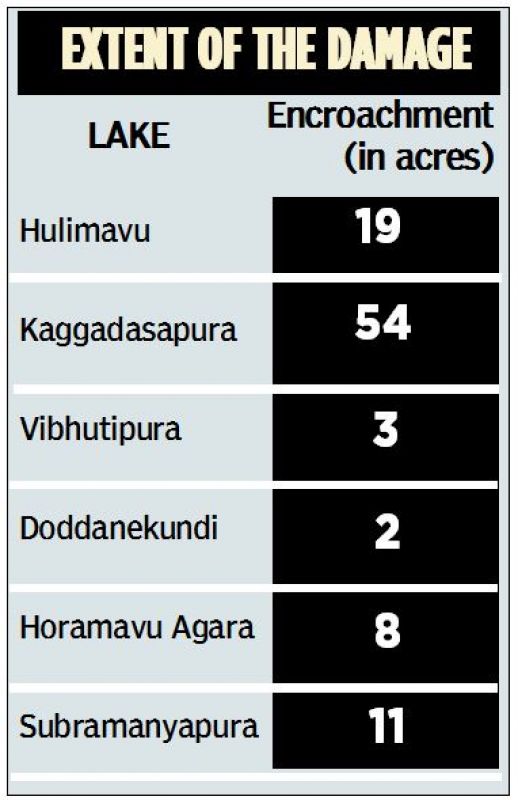In concrete jungle, no place for lung space
The BBMP's issuing of no objection certificates to large construction projects within the city worsens the problem.

Rapid concretisation of Storm Water Drains, encroachment of lakes and catchment areas and the inappropriate construction of shoulder drains has severely impacted, the city’s green cover with areas like Koramangala and Bellandur getting flooded in the monsoon. The BBMP’s issuing of no objection certificates to large construction projects within the city worsens the problem, reports Aksheev Thakur.
It’s a sad fact. The city is slowly turning into a concrete jungle, and besides losing its green cover, is seeing frequent flooding in rain. In fact, since 2000 its roads have been flooding even during normal rainfall, going by a recent study done by the Indian Institute of Science (IISc.). The survey reveals that not only has Greater Bengaluru grown by 1028 per cent, but the increase in concretisation has directly resulted in regular flooding of the city since 2000 even in a normal spell of rain.
Read | Concretisation is the problem and BBMP is also party to it: T V Ramachandra
The last monsoon, however, caused more distress than usual, with some of the city’s prime localities flooded in the rain, leaving people stranded in homes and dependant on boats to ferry them to safety. While Koramangala, Mysore Road and Bellandur, were among the worst hit, it was not just the rain that was responsible for the mess, reveals the IISc. study, blaming the increase in impervious areas with high-density urban development in catchment areas of nearby lakes coupled with the inappropriate construction of drains and concretisation of Storm Water Drains (SWD) for much of the disaster.
We can easily move the SEZ to Raichur or Belagavi, which will reduce the rush of people moving to the city and staying in slums here. This will also create job opportunities in these areas and save Bengaluru from being further choked. We should have a reverse migration process
— T.V. Ramachandra, professor, Indian Institute of Science
“There were two or three streams between Agara and Bellandur lakes which no longer exist. The rajakaluves have been narrowed and concretised. This has impacted the hydrological functional ability of the storm water drain in the area (which would otherwise have carried away the rain water),” says Mr TV Ramachandra, lead scientist of the IISc, who did the research along with his team.
Blaming the BBMP for spending crores on concretising the Storm Water Drains every few kilometers and also the BWSSB for issuing no objection certificates to industries in already heavily congested areas of the city, he now strongly suggests that the proposed Special Economic Zone coming up near Bellandur be transferred to another location.
“The SEZ will not only increase the traffic density but also have an adverse impact on the groundwater and will further concretise the city,” he warns, also noting that the encroachment of lakes for the construction of apartments and dumping of construction waste in the wetlands alters the topography of the city, which doesn’t bode well for it in the long run.
Mr Vijay Nishanth, a tree doctor, too believes that haphazard infrastructural planning has robbed the city of its green cover. “Lung spaces have decimated and wetlands have concretised , which does not allow the water to seep through. The damage could get unimaginable if things are not controlled on time,” he warns. Civic activists like Mr NR Suresh, convener of United Bengaluru, couldn’t agree more with the findings of the IISc. survey.
“There is zero accountability in government departments and I seriously doubt the engineering capability of the BBMP engineers. The IISc. study is right in saying that encroachments and concretization of wetlands have zeroed the possibility of water seepage,” he says with regret.
Solutions in IISc. study
- *Re-establish interconnectivity between lakes
- Stop narrowing and concretising drains
- Protect open spaces like parks and lakes
- Give environment clearances for projects strictly in accordance with the Environment Protection Act (2016)
Stop issuing NoCs for major projects
In the past not only did the city have more lakes, but they were also inter-connected, keeping it safe from flooding. Currently the city has a 1,000,000 km network of rivers, tributaries, lakes and SWDs. But the inter-connectivity between the lakes has been lost thanks to encroachments and increasing construction.
Lead scientist of the Indian Institute of Science (IISc.) T V Ramachandra, believes the lakes can be connected again. “When talks are on to link rivers, why cannot the lakes be interlinked?” he asks, arguing that this would be a cost-effective and people- friendly process. “We cannot concretise the city any further. We have already faced floods in the city and more concretisation will only inundate it more,” he warns.
Strongly coming out against allowing more industries to come up in Bengaluru, the IISc. survey has suggested that the government should give up the proposed special economic zone in the city. Mr Ramachandra believes this is essential. “We can easily move the SEZ to Raichur or Belagavi, which will reduce the rush of people moving to the city and staying in slums here. This will also create job opportunities in these areas and save Bengaluru from being further choked. We should have a reverse migration process,” he underlines.
The study has also suggested that the BWSSB should stop issuing NOCs for major construction projects. Thankfully, Chief Engineer of the water board , N Satish, says as of now it has not issued any NOC for any major building project in the Central Business District (CBD).
Water expert, Kshitij Urs has another solution too. “There are countries, which use porous bitumen for the construction of roads. This allows 70 per cent of the water to be absorbed into the ground unlike in India, where we don’t allow percolation of even a single drop of water,” he notes.


